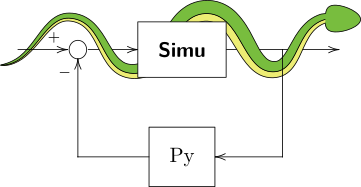
SimuPy is a framework for simulating interconnected dynamical system models and provides an open source, python-based tool that can be used in model- and system- based design and simulation workflows. Dynamical system models can be specified as an object with the interface described in the API Documentation. Models can also be constructed using symbolic expressions, as in
from sympy.physics.mechanics import dynamicsymbols
from sympy.tensor.array import Array
from simupy.systems.symbolic import DynamicalSystem
x = x1, x2, x3 = Array(dynamicsymbols('x1:4'))
u = dynamicsymbols('u')
sys = DynamicalSystem(Array([-x1+x2-x3, -x1*x2-x2+u, -x1+u]), x, u)which will automatically create callable functions for the state equations,
output equations, and jacobians. By default, the code generator uses a wrapper
for sympy.lambdify. You can change it by passing the system initialization
arguments code_generator (the function) and additional keyword arguments
to the generator in a dictionary code_generator_args. You can change the
defaults for future systems by changing the module variables
import simupy.systems.symbolic
simupy.systems.symbolic.DEFAULT_CODE_GENERATOR = your_code_generator_function
simupy.systems.symbolic.DEFAULT_CODE_GENERATOR_ARGS = {'extra_arg': value}A number of helper classes/functions exist to simplify the construction of models. For example, a linear feedback controller can be defined as
from simupy.systems import LTISystem
ctrl = LTISystem([[1.73992128, 0.99212953, -2.98819041]])The gains in the example come from the infinite horizon LQR based on the system linearized about the origin. A block diagram of the system under feedback control can be constructed
from simupy.block_diagram import BlockDiagram
BD = BlockDiagram(sys, ctrl)
BD.connect(sys, ctrl) # connect the current state to the feedback controller
BD.connect(ctrl, sys) # connect the controlled input to the systemInitial conditions for systems with non-zero dimensional state can be defined
(it defaults to zeros of the appropriate dimension) and the interconnected
systems can be simulated with the BlockDiagram's simulate method,
sys.initial_condition = [5, -3, 1]
res = BD.simulate(10)which uses scipy.integrate.ode as the default solver for the initial-valued
problem. The results are an instance of the SimulationResult class, with
array attributes t, x, y, and e, holding time, state, output,
and event values for each integrator time step. The first axis indexes the time
step. For x, y, and e, the second axis indexes the individual
signal components, ordered first by the order each system was added to the
block diagram then according to the system state and output specification. The
simulation defaults to the dopri5 solver with dense output, but a different
integrator_class and integrator_options options can be used as long as
it supports a subset of the scipy.integrate.ode API. The default values
used for future simulations can be changed following the pattern for the
symbolic code generator options.
A number of utilities for constructing and manipulating systems and the simulation results are also included:
process_vector_argsandlambdify_with_vector_argsfromsimupy.utils.symbolicare helpers for code generation usingsympy.lambdifysimupy.utils.callable_from_trajectoryis a simple wrapper for making polynomial spline interpolators usingscipy.interpolate.splprepsimupy.matricesincludes tools for constructing (vector) systems using matrix expressions and re-wrapping the results into matrix formsimupy.systems.SystemFromCallableis a helper for converting a function to a state-less system (typically a controller) to simulateMemorylessSystemandLTISystemare subclasses to more quickly create these types of systemsSwitchedSystemis used to construct systems with discontinuities, defined by zero-crossings of theevent_equation_functionoutput.
The examples subdirectory includes a number of worked problems. The documentation and docstrings are also available for reference.
Version 1.0 of SimuPy is pip installable
$ pip install simupyHowever, the latest features and examples are only available in the development version. To install,
$ git clone https://github.com/simupy/simupy.git
$ pip install -e simupySimuPy has been tested locally against
but tests on Travis may run with newer versions. Much of the functionality works without SymPy, so installation does not require it. The examples use matplotlib to visualize the results. Testing uses pytest. The documents are built with Sphinx == 1.6.3.
- To discuss problems or feature requests, file an issue. For bugs, please include as much information as possible, including operating system, python version, and version of all dependencies.
- To contribute, make a pull request. Contributions should include tests for any new features/bug fixes and follow best practices including PEP8, etc.
